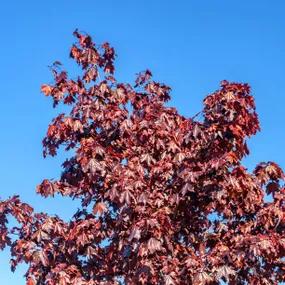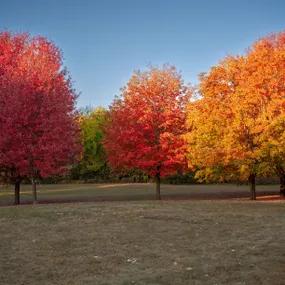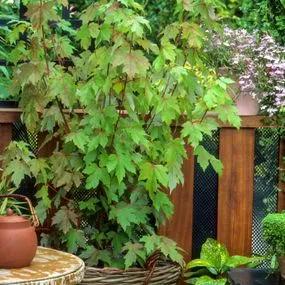Maples (Acer species) are versatile trees that tolerate a range of soils and sites with light conditions from full sun to partial shade. Acer trees with variegated foliage tend to do better out of the midday sun. The trees in our range grow to between 5 and 35 metres tall, suitable for gardens of any size.
As a family, the Acers are pretty trouble free and disease resistant. Pretty much their only requirement is that they have reasonable drainage.
What size Maple trees should I buy?
- If you are not in a hurry to get a full sized Maple tree, we recommend starting with the smaller 6/8cm girth size.
- If you are in a hurry and need instant impact, then go for the 8/10cm girth size.
Standard trees are measured by their girth 1 metre above the ground, and young saplings are measured by height. Therefore, a 6/8cm Standard Maple tree is much bigger than an 60/80cm sapling Maple tree. If a tree is available in both sizes, it will be noted in the product descriptions.
Browse our full range of Garden Trees.
- Order now, pay later: we don't charge your card until before delivery
- When your order is ready: your mail order trees are delivered by next working day courier (not the next working day after ordering!)
- Friendly support: if there is anything wrong with your plants when you inspect them, Contact Us within 5 working days
All bareroot plants are covered by our Refund Guarantee, so you can give them a whirl with complete confidence.
With our varied range of elegant maples, UK gardeners have a wide choice of responsibly grown maple trees to choose from.
Do Maple Trees Flower?
Yes, maple trees do produce flowers and also winged seeds called samsaras. Most maple tree flowers are inconspicuous and produce small blooms best observed up close. Depending on the species, flower colours vary from orange, red, yellow and green and usually bloom just after the leaves appear.
Where can I grow Maple Trees?
Maple trees are very easy to grow in practically any fairly sheltered location that is not prone to waterlogging, but will still thrive next to water.
The ideal soil is rich and moist. On dry, poor soil, add plenty of organic matter and mulch yearly.
They are reasonably shade-tolerant, so partial shade is fine, and some species will do well in close to full shade. However, as with so many trees, if the variety has red or purple leaves, it will colour up best in the sun.
Japanese maples should always be planted in sheltered locations because too much wind ruins the appearance of their foliage.
The toughest, most wind-resistant varieties are our native field Maples, Acer campestre (their saplings are used in mixed country hedging), which includes the more compact cultivars Streetwise, Elsrijk and the red-purple leaved Royal Ruby.
When and How do I plant Maple Trees?
You can plant Pot Grown Maple trees at any time of year, and Bareroot trees during winter, except when the soil is frozen.
The best time to plant Maple trees is from late Autumn to early Spring (November to March), using bareroot stock, which is cheaper, easier to carry and plant, and tends to establish even better than their pot grown equivalents.
Watch our Tree Planting Video for instructions.
We strongly recommend using Rootgrow.
Aftercare:
Remember: the two biggest killers of recently transplanted trees are underwatering, and being choked by weeds and grass.
- Regular, thorough watering is vital during dry weather in their first spring and summer, and highly recommended the following summer, especially if there is a heat wave.
- Either remove weeds and grass by hand periodically, or use some form of mulch to suppress them.
Tree Planting Accessories
Standards that are 6/8cm in girth and upwards are quite big trees, so they need a tree planting stake and a tree tie (with a buffer between the tree and the stake) during their first couple of years.
A mulch mat is will suppress weeds & grass, and preserve moisture: remember that dry soil and competition with weeds are the two biggest killers of new trees.
Even with a mat, you should remove anything that manages to grow up between the mat and the trunk in late spring and summer.
You can buy those items separately, or save money with our Tree Planting Pack.
You definitely need a tree guard if there are deer or rabbits about.
In urban areas with no wild animals, tree guards are great for protecting against mowers and strimmers.
For that purpose, you can cut one tree guard into several pieces about 20-25cm long, to act as skirting around the base of the tree.
Mycorrhizal Fungi
We cannot recommend using Rootgrow fungi enough: it makes a huge difference, especially with larger trees, which are scrambling to regrow the root systems that they lost when we dug them up, in order to support their now top-heavy growth above ground.
Mycorrhizal fungi assist the roots in accessing soil nutrients and water, and protect the roots from soil critters.
In return, the tree shares sugar with them, and the result can be over 50% more growth above ground!
How fast do maple trees grow?
Japanese maples are famously slow-growing trees, making them simply outstanding garden trees that can maintain their shape and structure for many years without pruning.
Other maples, especially Sycamores (Acer pseudoplatanus) and the silver maple (Acer saccharinum) grow very quickly.
They can self-seed fairly readily from their winged "helicopter" fruit, which spin gently to the floor, evoking playful British autumns.
What tree has helicopter seeds?
In the UK, trees with helicopter seeds are either in the Acer family, such as maple and sycamore, or they are Ash trees, Fraxinus excelsior, which all have dieback disease and are no longer sold.
To identify the helicopter seeds is easy. The Acer family, maple and sycamore, has seeds with two wings, while Ash tree seeds have only one wing.
There are two easy ways to remember that distinction: Maple or Sycamore are both longer words than Ash, or Acer reminds you of a flying Ace in a bi-plane.




 Hero Img.webp)

.webp)
 Hero Img.webp)
 1.webp)
 Hero Img.webp)

 Hero Img.webp)

 Hero Img.webp)
 hedging 2.webp)
 1.webp)
 Hero Img.webp)
 2.webp)
 1.webp)
 2.webp)